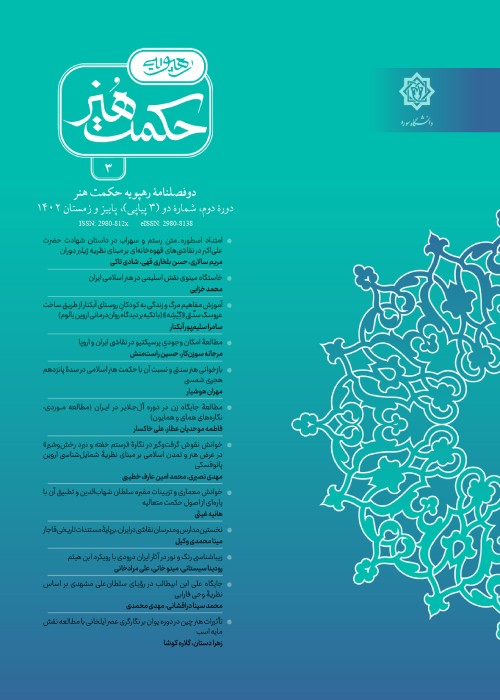Continuity of Christian philosophy in Renaissance humanist painting
Author(s):
Article Type:
Research/Original Article (بدون رتبه معتبر)
Abstract:
The humanism of Renaissance art is generally considered the most important difference between it and Christian art of the middle centuries. Due to the fact that in the Renaissance era, a precise philosophy was not formed regarding the definition of man and his place in existence, the theoretical foundations of the emergence of Renaissance humanistic art are subject to many questions. By looking at the opinions of medieval theologians and studying its continuation in the Renaissance period, it is possible to recognize some roots of the formation of the mentioned art. Saint Augustine, in the doctrine of "I believe in order to understand", on the one hand considered religious faith as the source of rational knowledge, and on the other hand, in the depth of meaning, he considered the truth of perception and knowledge dependent on human action.Abelard's theory of doubt as a means to reach the truth, Saint Francis's explanations regarding the fact that the truth is below and inside man rather than above, as well as the belief in the originality of the individual, which was proposed by Ockham, as the theological foundations of the Middle Ages in Along with the scientific achievements of the Renaissance, they were effective in the formation of the humanistic philosophy of that period.After studying and recovering the effects of medieval philosophy on the renaissance period, this article tries to follow the similarity of the mentioned philosophical developments in the world of art. The research method in this article is descriptive and analytical, information collection is done in a library style and data analysis is done in an inductive way. According to the findings of the research, it is clear that the ruling opinions of Christian theologians were effective in the formation of modern thought and, accordingly, the humanistic art of the Renaissance. In the emergence of perspective rules as artistic Subjectivism and also in the representation of God-like man, this effectiveness can be clearly recognized. Although Renaissance painting emphasized natural beauty and physical forms, it did not lose the religious meaning of the past. The simple figures of the past gave way to a kind of luxurious beauty, self-presenting faces with precious clothes, which were obviously full of worldly power and lust. Even the image of the God of Christianity was depicted in the form of a strong and beautiful human. The human-like and powerful God had a sign of belief in God's existential dominion over human rationality. On the other hand, the discovery of new rules of perspective in Renaissance artworks was an attempt to create a rational methodical knowledge of the outside world. Although this vision is apparently at the opposite point of the pictorial tradition of the Middle Ages; However, due to the fact that the principles of philosophy based on the originality of the subject were not explained in this period, it is possible to look for the roots of some of the achievements of the Renaissance era in the past. Where Abelard, by emphasizing the place of doubt as a means of receiving truth, gave theological perception a human and indeterminate nature, or Ockham, who considered science to be the product of human experience and observation, all of them are in the malleability of the idea of representing the world based on indeterminate rules and human sensibility. And finally, the establishment of deepening laws were effective.
Keywords:
Language:
Persian
Published:
Journal of Rahppoye, Hekmat-e Honar, Volume:1 Issue: 1, 2022
Pages:
47 to 59
magiran.com/p2519495
دانلود و مطالعه متن این مقاله با یکی از روشهای زیر امکان پذیر است:
اشتراک شخصی
با عضویت و پرداخت آنلاین حق اشتراک یکساله به مبلغ 1,390,000ريال میتوانید 70 عنوان مطلب دانلود کنید!
اشتراک سازمانی
به کتابخانه دانشگاه یا محل کار خود پیشنهاد کنید تا اشتراک سازمانی این پایگاه را برای دسترسی نامحدود همه کاربران به متن مطالب تهیه نمایند!
توجه!
- حق عضویت دریافتی صرف حمایت از نشریات عضو و نگهداری، تکمیل و توسعه مگیران میشود.
- پرداخت حق اشتراک و دانلود مقالات اجازه بازنشر آن در سایر رسانههای چاپی و دیجیتال را به کاربر نمیدهد.
In order to view content subscription is required
Personal subscription
Subscribe magiran.com for 70 € euros via PayPal and download 70 articles during a year.
Organization subscription
Please contact us to subscribe your university or library for unlimited access!



